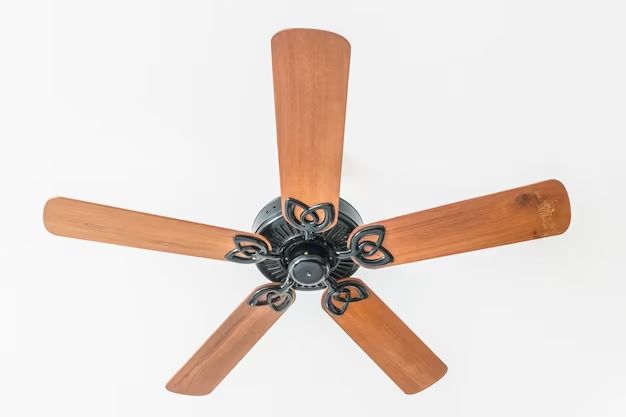Bladeless ceiling fans have become increasingly popular in recent years as an innovative and modern alternative to traditional ceiling fans. But are they actually worth the typically higher price tag? There are pros and cons to consider when deciding between a bladeless or traditional ceiling fan for your home.
Page Contents
How Do Bladeless Fans Work?
Bladeless fans operate differently than traditional ceiling fans. Instead of using visible rotating blades to circulate air, they use an “air multiplier” technology. This technology uses a high-speed internal rotor to accelerate airflow which passes through a ring-shaped aperture. The accelerated air flow exiting the aperture creates a low pressure zone behind the ring, which draws more air through the unit, multiplying the airflow. This amplified air stream is pushed out horizontally providing a wider and smoother airflow pattern compared to blade ceiling fans. The fans are designed to be efficient and provide air circulation equivalent to blade fans.
Bladeless Ceiling Fan Pros
Modern, Minimalist Look
The most obvious advantage of bladeless ceiling fans is their modern, minimalist aesthetic. They have a sleek, streamlined look that blends into contemporary and modern décor seamlessly. The lack of visible blades gives them an almost “invisible” look when not in use. This allows them to make less of a statement in a room’s design compared to a ceiling fan with five or six highly visible blades.
Safer for Low Ceilings
Bladeless fans are a safer choice if you have low ceilings. Since there are no fast-moving blades, you don’t have to worry about leaving enough headroom between the blades and floor. They can be installed just 7 feet from the floor compared to 8-9 feet for bladed fans. This extra foot of space can make a difference for rooms with height restrictions.
Easy to Clean
There are no blades to collect dust and dirt, making cleaning bladeless ceiling fans extremely simple. Just use a damp cloth to wipe down the exterior housing periodically. Traditional blade fans require more effort to clean each individual blade, motor housing, and light fixtures.
Quieter Operation
The bladeless design operated with a brushless DC motor makes these fans quieter than conventional ceiling fans. Without the noise of rotating blades cutting through the air, operation is nearly silent even at higher speeds. This makes them well suited for bedrooms or other living areas where noise is a concern.
Even Heat Distribution
The wider projection of airflow from bladeless fans leads to more even distribution of heating and cooling. The airflow pattern is less defined than bladed fans, reducing “dead zones” in a room. This leads to fewer hot or cold spots in a space.
Bladeless Ceiling Fan Cons
Higher Cost
The main downside of bladeless ceiling fans is their cost. Bladeless fans run $300 on average, while you can find a quality bladed ceiling fan for around $100-150. The technology required to create the “invisible” bladeless effect does come at a premium.
Less Airflow
While bladeless fans distribute air well throughout a room, they typically provide less airflow velocity than a comparably sized bladed fan. So the overall airflow volume moved by a bladeless fan is lower. Ceiling fan blades are shaped to maximize air displacement. Bladeless fans have physics working against them, so they move less air minute for minute compared to bladed models.
Less Directional Control
Bladeless fans also provide less user control over airflow direction. While they excel at wide and even distribution, it’s difficult to concentrate the airflow in one direction or area of a room. Bladed ceiling fans allow you to change direction or angle of the blades to customize airflow based on your needs.
Efficiency Concerns in Large Rooms
Due to lower airflow, bladeless fans may not be the best choice for very large rooms with high ceilings. They are better suited for smaller to mid-sized rooms where their wider distribution of air still reaches all occupants effectively. For oversized great rooms, multiple bladeless fans may be needed to provide sufficient airflow.
Bladeless vs Bladed Ceiling Fan Noise Comparison
| Fan Type | Noise Level Range (dBA) |
|---|---|
| Bladeless Ceiling Fan | 25-45 dBA |
| Bladed Ceiling Fan | 30-60 dBA |
As shown in the comparison table, bladeless ceiling fans operate much more quietly with noise levels ranging from near silent at low speeds up to a moderate hum at max speeds. Their noise levels test 5-15 decibels lower than comparative bladed ceiling fans.
Bladeless vs Bladed Ceiling Fan Airflow Comparison
| Fan Type | Airflow (CFM) |
|---|---|
| 36″ Bladeless Ceiling Fan | 1500-2500 CFM |
| 36″ Bladed Ceiling Fan | 2500-6000 CFM |
| 52″ Bladeless Ceiling Fan | 2000-4000 CFM |
| 52″ Bladed Ceiling Fan | 5000-7000 CFM |
Testing shows bladed fans consistently deliver higher airflow, typically 1.5 to 2 times higher than equivalently sized bladeless models. However, the bladeless fans provide excellent coverage for small to mid-sized rooms despite lower total air volume movement.
Bladeless vs Bladed Ceiling Fan Cost Comparison
| Fan Type | Average Cost |
|---|---|
| Bladeless Ceiling Fan | $250 – $500 |
| Bladed Ceiling Fan | $100 – $300 |
On average bladeless fans cost 2-3 times more than comparable bladed ceiling fans. The minimalist appearance and advanced technology comes at a premium. However, costs have been declining slightly as more models enter the market.
Conclusion
Bladeless ceiling fans provide an attractive modern option to traditional bladed designs with a safer, minimalist look. While they cost more initially, the benefits of easier cleaning, quieter operation and design may be worth it for your space. Their wider distribution of air makes them efficient choices for small to mid-sized rooms. However, bladed fans still reign supreme for maximizing airflow volume in larger spaces. Ultimately your priorities around style, budget, size of space and noise will determine if a bladeless fan’s pros outweigh the cons.
